Bison return to Texas Indigenous lands, reconnecting tribes to their roots
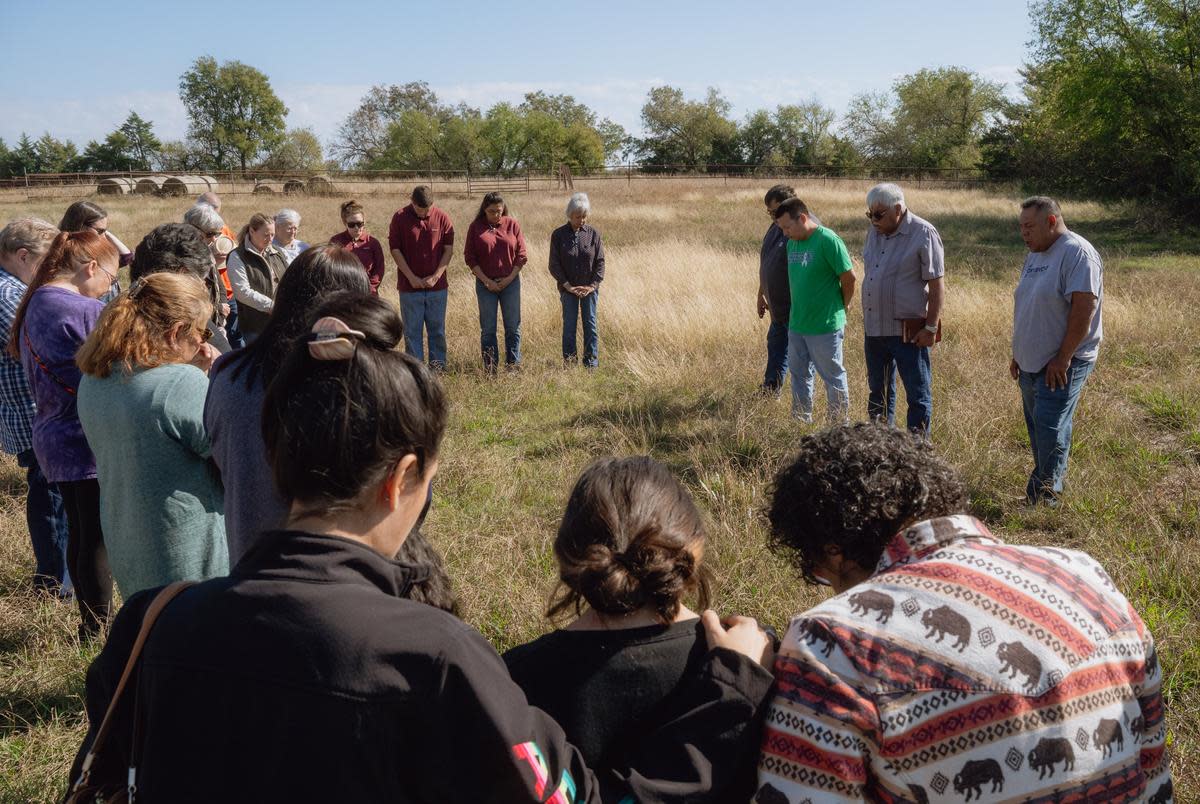
SULPHUR SPRINGS — Silence falls over a crowd of 40 people on a windy afternoon in early November, each breath held in anticipation as two 800-pound bison slowly approach.
Among the spectators are Native Americans from various tribes, some who traveled two to three hours to experience the awe of seeing bison up close for the first time.
A female bison less than 100 feet from the crowd bellows, signaling the others with a nod of her head that the coast is clear. The rest follow, advancing toward the mesmerized onlookers. Phones rise as spectators eagerly capture the intimate moment.
The bisons’ new home is the 60-acre GP Ranch in Hopkins County, about 90 miles northeast of Dallas, owned by Muscogee (Creek) Nation member Theda Pogue.
Pogue, 45, received the four cows and one bull earlier that week from the Medano-Zapata Ranch Preserve, a nature conservancy ranch in Colorado. It’s part of an effort by the Tanka Fund, a native-led nonprofit based in South Dakota, and The Nature Conservancy to restore more than 700 bison — also known as American buffalo — to Indigenous lands across the country this fall in partnership with tribal nonprofits and nations.
Pogue invited people to her ranch on National Bison Day, Nov. 4, to celebrate.
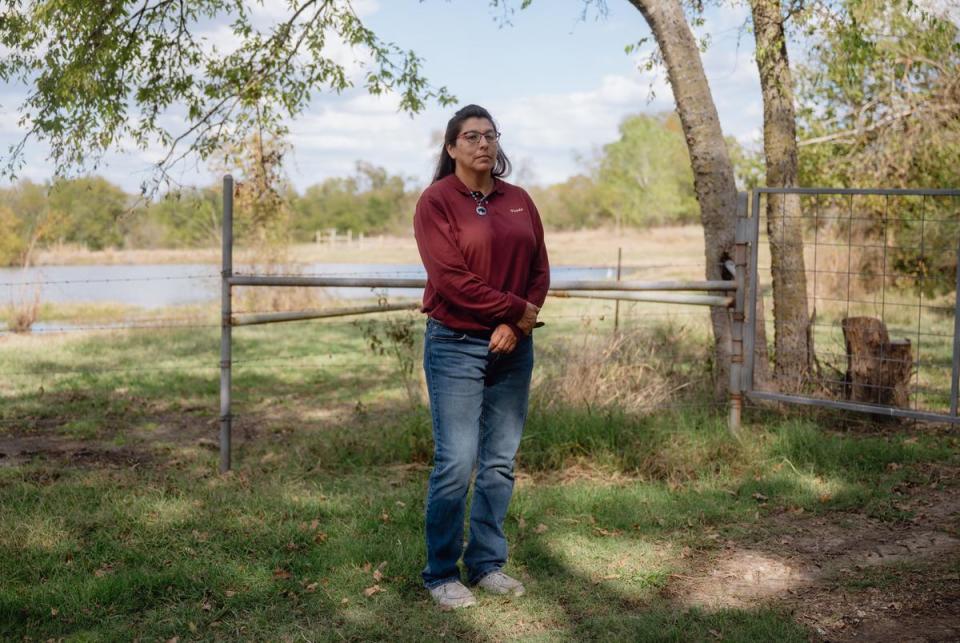
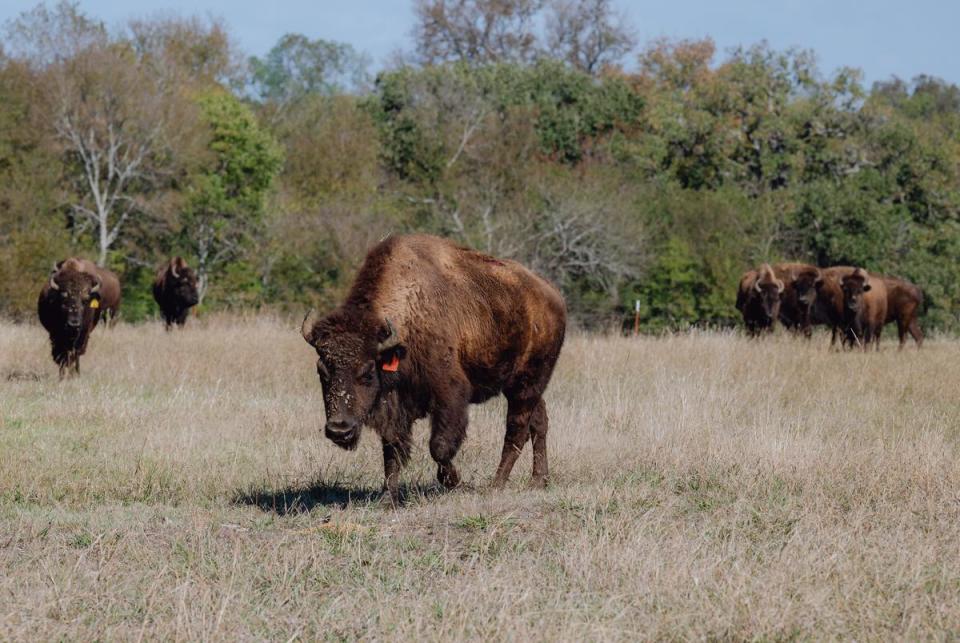
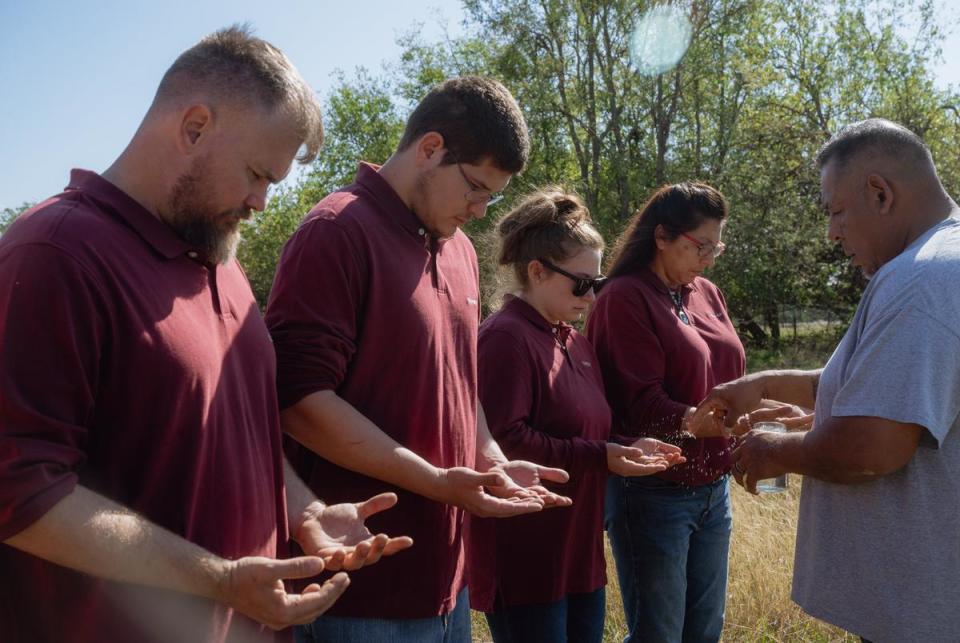
The arrival at Pogue’s ranch marks the second bison transfer to Texas through the program; the first one was a transfer of five bison to a Lipan Apache ranch in Waelder, an hour east of San Antonio. These new bison bring Pogue’s herd to 12 — one bull and 11 cows.
As the ceremony begins, the people form an arc around four Native American men whose voices intertwine in a song as birds circle above.
When they conclude, Pogue tells the crowd that the day feels like a gift. She wears a silver necklace with a black buffalo pendant surrounded by turquoise beads.
“This herd is for us to share with our younger generations who will know what our ancestors have gone through,” Pogue says between pauses as she tries to control her happy tears.
“Their strength, that honor and that dignity flows through my veins,” she continues. “We are strong. We are still standing here today and we will still be standing here tomorrow just like the buffalo.”
Later, the Rev. Eric Thlocco of Tokvbvche Methodist Church blesses Theda, her two kids and her husband, anointing their hands with holy water. Theda, with wet hands, tenderly pats the holy water over her body.
Then Thlocco, a member of the Seminole Nation of Oklahoma, sprinkles the land with holy water “to watch over these buffalo, take care of them and bless the family that is going to watch over them.”
Bison nearly died out
Earlier that morning, Ronnie Thomas, 61, affiliated with the Alabama-Coushatta Tribe of Texas, helped Pogue set up a tipi, opening the flaps to let air in during the day. Thomas was one of the first guests to arrive at Pogue's ranch. He drove three hours from Livingston.
Struggling for words, Thomas said, “it’s hard to describe the meaning of the animal.”
“Buffalo, bison is considered sacred,” he said as he pointed to a table holding a bison skull, a bison horn — which is blown four times at the start of a Native American service or ceremony — and other regalia made from parts of the animal.
Millions of bison once roamed the plains, including parts of Texas. Early Spanish explorers in North America reported that bison were as numerous as “fish in the sea.” Native Americans relied on the massive herds for food, clothing, medicine and spiritual practices.
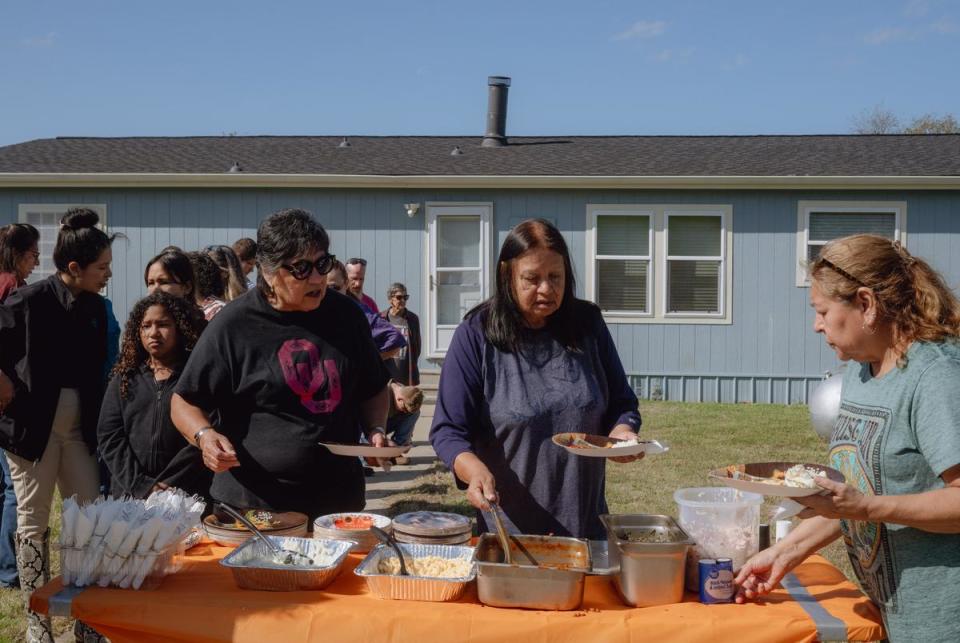
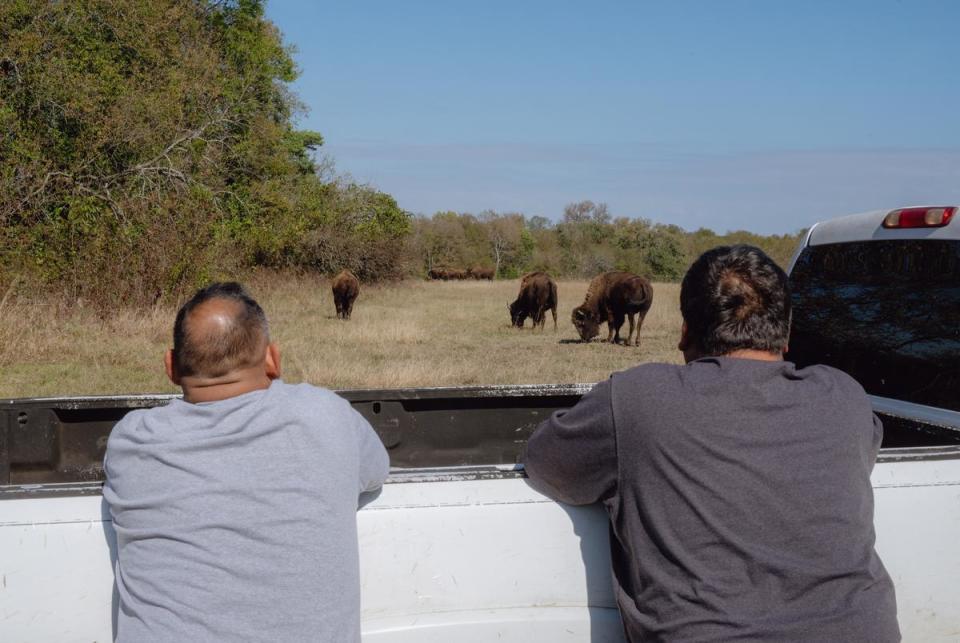
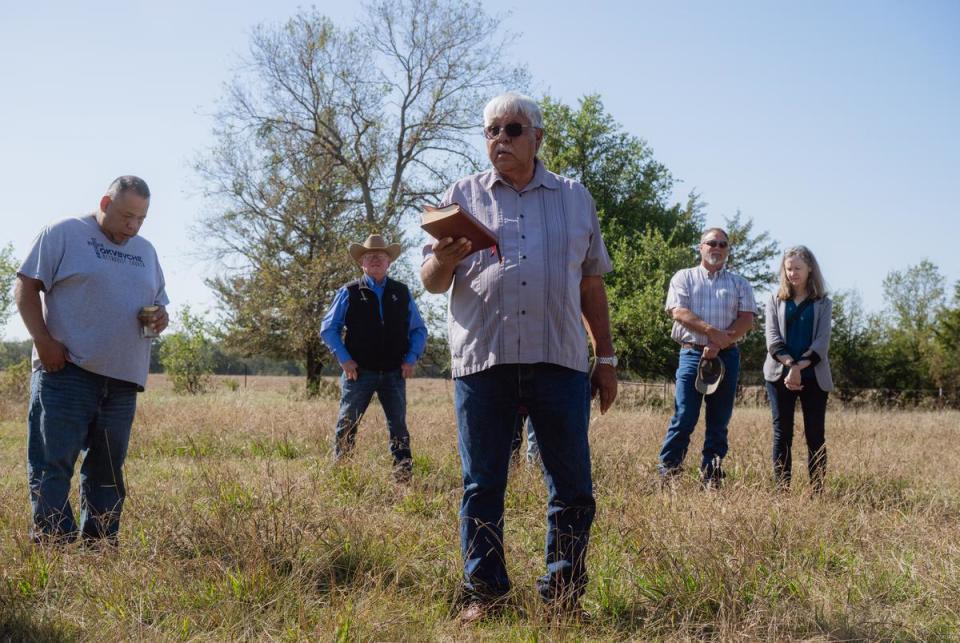
In the 1800s, the bison population suffered a catastrophic decline after the arrival of new settlers and bison hunters.
The "Great Slaughter" of bison between 1820 and 1880 was driven by the U.S. government promoting the mass hunting of bison in an effort to subdue Native American tribes, along with construction of the transcontinental railroad, which disrupted migratory patterns. By the 1890s the bison population dwindled to near extinction, with fewer than 1,000 remaining.
Indigenous communities whose way of life depended on the bison were forced onto reservations.
Efforts to save the bison from extinction began in the early 1900s when Yellowstone National Park managers purchased 21 animals from private owners to preserve one of the last free-roaming bison herds.
Today, there are more than 400,000 bison in commercial herds around the country; about 20,000 more roam free in conservation herds. One of the biggest herds in Texas is the official state herd at Caprock Canyons State Park, which numbers more than 240 bison, according to Jamie Killian, a regional natural resources coordinator for state parks for the Texas Parks and Wildlife Department.
Bison preservation
For decades, government agencies and nonprofits have helped to restore bison herds on Native American reservations through transfers. The Tanka Fund, the nonprofit out of South Dakota, is trying to make that possible for Native Americans who do not live on a reservation.
In Texas, only three federally-recognized tribes have reservations: the Alabama-Coushatta, Tigua, and Kickapoo.
“We are supporting native-run projects, because there’s no other outlets or other places for them to get assistance,” said Trudy Ecoffey, executive director of the Tanka Fund.
Pogue remembers first hearing about the bison's cultural connection to Native Americans at school in Oklahoma, where she was born and raised. When she was in elementary school, her class took a field trip to a bison farm in Wewoka.
She later joined the U.S. Navy, where she met and married her husband Chris. They moved to California, where Chris worked at a ranch that raised bison. That experience inspired them to buy their own ranch and raise bison.
In 2017, after they retired from the Navy, the couple invested their full retirement into a Texas property that they named GP Ranch and dove into bison ranching. They began a business selling bison meat to five brick-and-mortar stores.
Theda Pogue said they had second thoughts about the business and sold their herd.
"We decided that [selling bison meat was] not where we wanted to be,” she said. “It's not where we felt like we were being called to be at."
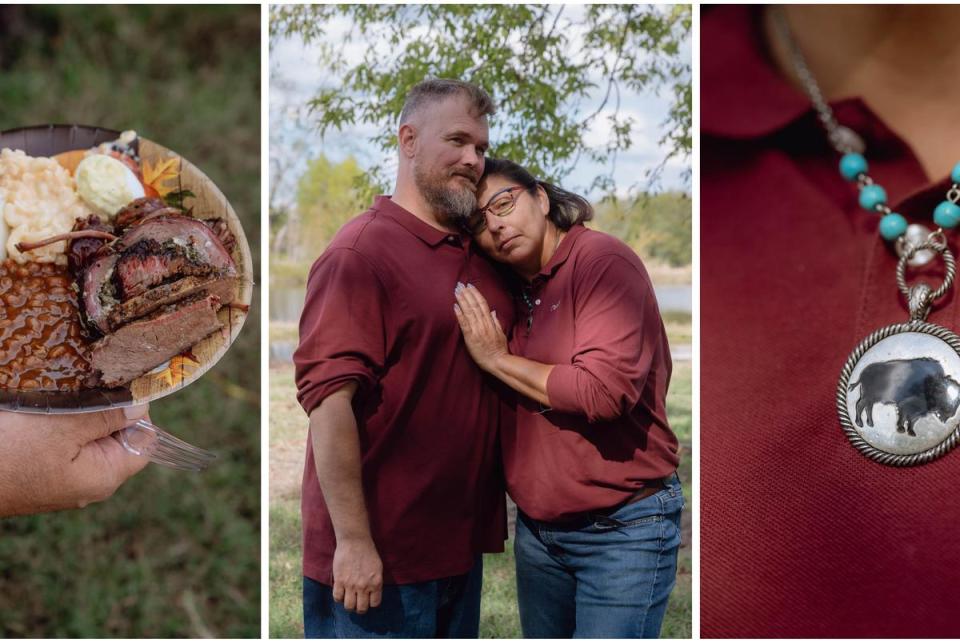
As she learned about other tribes’ bison education and conservation projects, she and her husband decided to give raising bison another go, this time as conservationists.
When a rancher called her and said he needed help raising and grazing his bison, the Pogues offered their land for two of his animals. They also bought three bison — two of them were pregnant — from a rancher in East Texas.
Later, the Tanka Fund approached them about applying for a grant to receive five more bison.
Pogue applied for the transfer in September and said she received a call from the Tanka Fund in late October telling her the news that they received a $14,000 grant to raise the bison and build a hay barn for them. She quickly booked the first flight to Colorado, loaded them onto trailers and drove 13 hours back to her ranch in Sulphur Springs.
The bison came from one of The Nature Conservancy’s 11 preserves with bison herds, the Medano-Zapata Ranch Preserve, a 100,000-acre grassland home to a herd of approximately 2,000 bison. Since the Nature Conservancy joined the InterTribal Buffalo Council and Tanka Fund in 2020, it has supported the transfer of thousands of bison.
At the ranch, some of Pogues’ bison have dirty fur from wallowing — rolling in dirt to deter biting flies. Bison can live up to 20 years and are led by a matriarch rather than a bull, and the cows begin breeding at two years old. Pogue said her family will begin checking for pregnant cows soon.
Chris Pogue, 43, said the family would like to keep the herd small to ensure they can survive by grazing alone. He said the bison’s grazing behavior is good for the environment because they prefer grasses and often avoid other plants, leaving some areas ungrazed, which helps plant diversity.
Right now, the Pogues are hoping the new bison will easily integrate with their existing herd. They’ve already witnessed some pecking order disputes, but “they will get it worked out and eventually it will be a cohesive unit,” Chris Pogue said.
Theda hopes once they’ve adjusted, she can start her mission: creating a place for Indigenous people to reconnect with the bison.
“I have always been taught, if you're given an abundance of something, you don't build a high wall to keep it to yourself, you build a bigger table to share it with everybody else,” she said.
Passing down the bison’s cultural legacy
Andrea Poncho, a 51 year-old member of the Alabama-Coushatta Tribe of Texas, said her kids had no idea the treat they were in for when they arrived at GP Ranch that morning from Livingston.
Her sons Waylon, 7, and Gunnar, 6, experienced a lot of firsts: running in and out of a tipi, a bumpy hayride on the back of a trailer attached to a white 2004 Chevy Silverado and seeing bison up close.
“They don’t know the background or what the purpose of all of this is,” Poncho said. “This will be educational for them.” It was her first time seeing bison in person, too.
When the bison stepped slowly toward the crowd, the boys stopped picking the grass in front of them and stood up, staring in wonder.
“They are coming,” whispered Gunnar, his hands covering his mouth.
“They are kind of cute,” Waylon said.
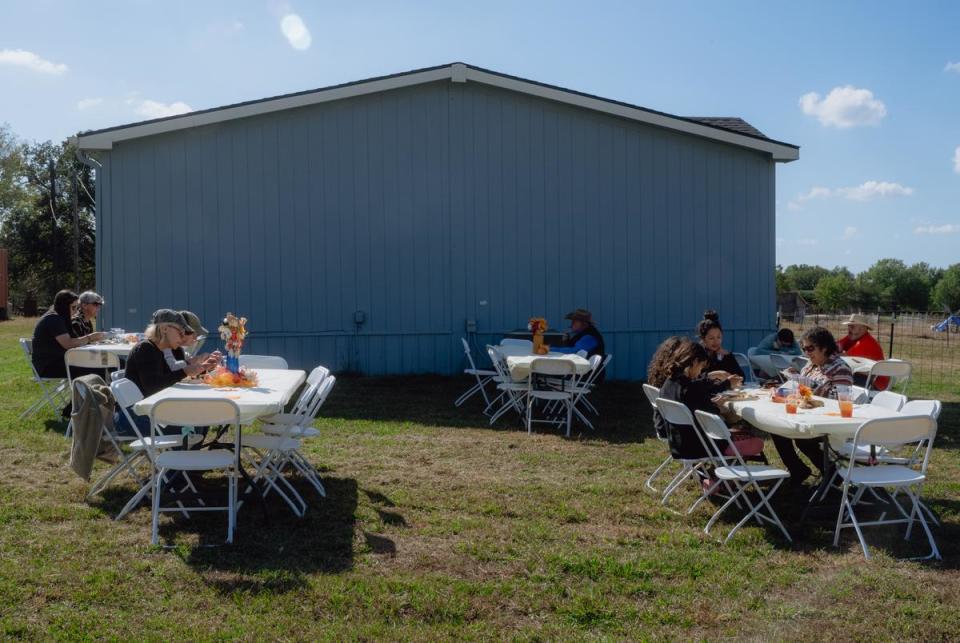
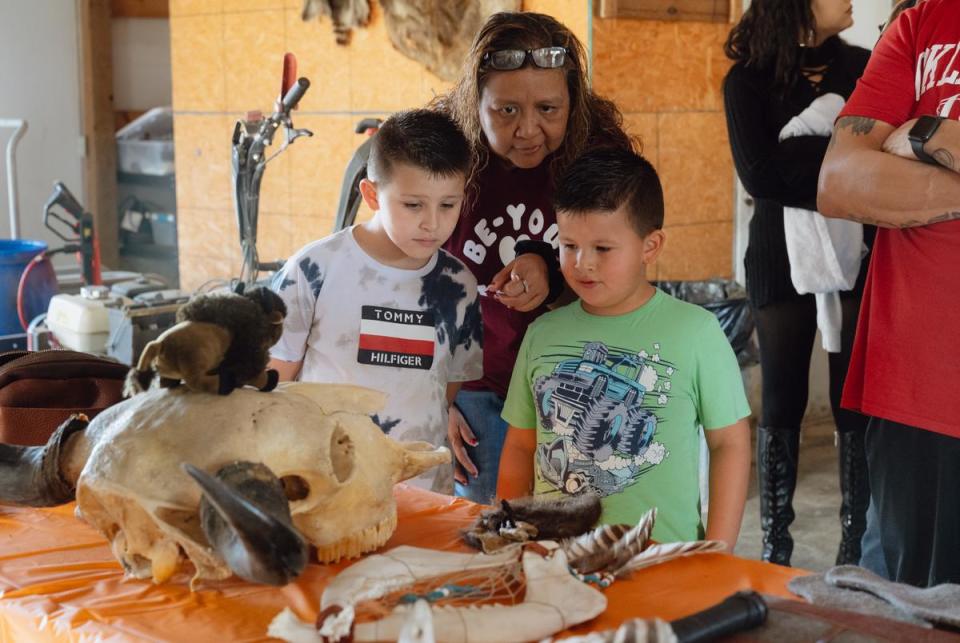
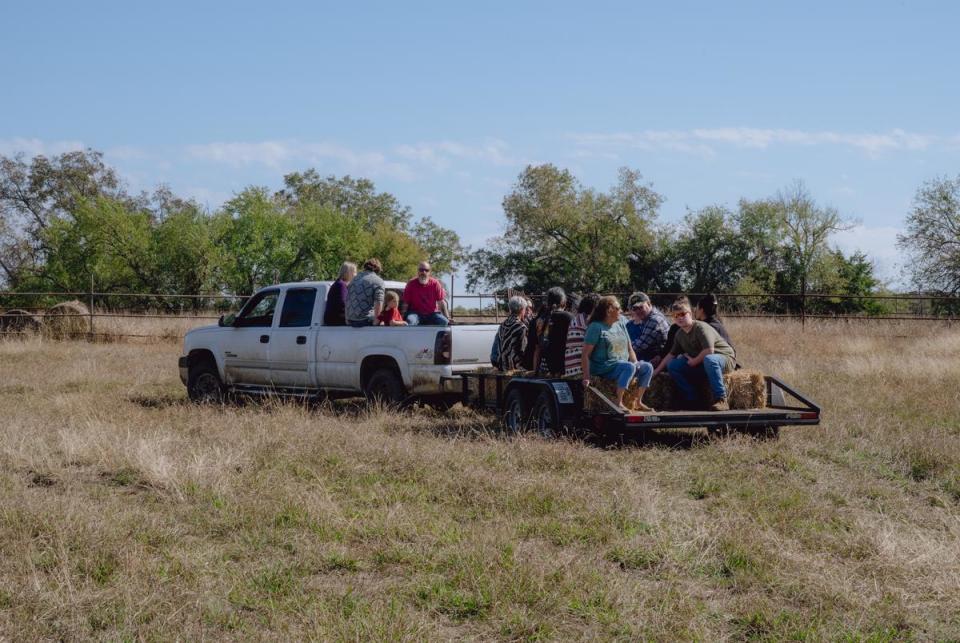
A couple feet away stood the Cortez family — 57-year-old Donna Cortez McCormick, her daughter Candice Cortez and her two granddaughters. The family had traveled from Irving that morning to see the bison. Cortez McCormick said she knows they have Indigenous roots, and she is starting to research her family’s forgotten history to pass down to her children and grandchildren.
“I’ve always felt the connection, you feel something but just are not quite sure what it is,” she said. “You have the spirits inside you and the buffalo is one of them.”
Wearing a jacket with a black buffalo pattern, Cortez McCormick said bringing her daughter and granddaughters to events like these is a way to start learning about their heritage.
“We’ve lost so many people [in our family],” Candice Cortez, 36, said. “We are barely researching our family's past, the reservation that we come from and about our ancestors.”
After a five-minute hay ride back to a building on the ranch, the kids grabbed paper and crayons and began coloring bison drawings, next to a pile of pamphlets: 10 fascinating facts about the buffalo.
As a member of the Muscogee (Creek) Nation, Pogue said she was happy to see that so many tribal members brought kids and teenagers to the ranch. She’s in the early stages of arranging a trip for youth with the Alabama-Coushatta Tribe of Texas to see the bison and share oral histories.
She said that many younger generations may have forgotten what bison has represented for Native Americans. She wants to change that.
“So one of our goals is education and reminding Native Americans where they came from.”
Disclosure: The Texas Parks And Wildlife Department and The Nature Conservancy have been financial supporters of The Texas Tribune, a nonprofit, nonpartisan news organization that is funded in part by donations from members, foundations and corporate sponsors. Financial supporters play no role in the Tribune's journalism. Find a complete list of them here.
Correction, Nov. 13, 2023 at 10:59 a.m. : A previous version of this story incorrectly stated the number of cows in the Pogues' bison herd. There are 11 cows in the herd.

